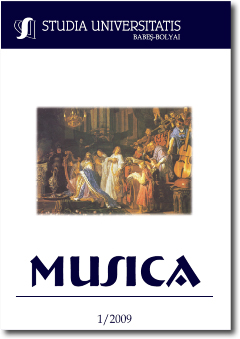EDUARD TERÉNYI’S STABAT MATER
EDUARD TERÉNYI’S STABAT MATER
Author(s): Anamaria Mădălina HotoranSubject(s): Music
Published by: Studia Universitatis Babes-Bolyai
Keywords: Eduard Terényi; cross; suffering; glory; Virgin Mary; form; structure; variation; symmetry; folklore; central axis;
Summary/Abstract: Stabat Mater (1991) for two women soloists, women’s choir, percussion and organ by Eduard Terényi is a contemporary replica to the medieval poem, echoing some of the local literary and musical features, as cultural reference to a certain point in the local music history and to their geographical space. Exploring the stratum of the catholic melodies from the sixteenth - seventieth centuries in Transylvania, Eduard Terényi achieves the synthesis between Hungarian folk music and the European music. Therefore, the literary support of the first three parts of the work are religious folk lyrics in the Hungarian language, taken from Erdélyi Zsuzsanna’s collection Hegyet hágék, lőtőt lépék and the last three parts include Latin texts and melodies from Ion Caioni’s Cantionale Catholicum. The musical structure of Stabat Mater is determined by the content of the ideas, the earthly moments of pain and further transfiguration in the celestial world. Each of Holy Mary’s two hypostases occupies three parts: her earthly state as Mater Dolorosa in the first three parts and the celestial one as Regina Coeli in te last three parts. In the fourth part, the author has selected six strophes of Stabat Mater, intending to picture Christ’s crucifixion as the central axis of the work. Around this nucleus and in the light of the folk ethos, a framework is woven for the psychological drama, whose character is Holy Mary, Christ’s mother. The medieval poem not only contributes to the consistency of the dramatic plot, but it also represents the axis of multileveled mirror symmetry: the symmetrical unfolding of the semantics determines the symmetrical arrangement of the tonalities and their ethos, of musical macro-form and material.
Journal: Studia Universitatis Babes-Bolyai - Musica
- Issue Year: 54/2009
- Issue No: 1
- Page Range: 279-296
- Page Count: 18
- Language: English

